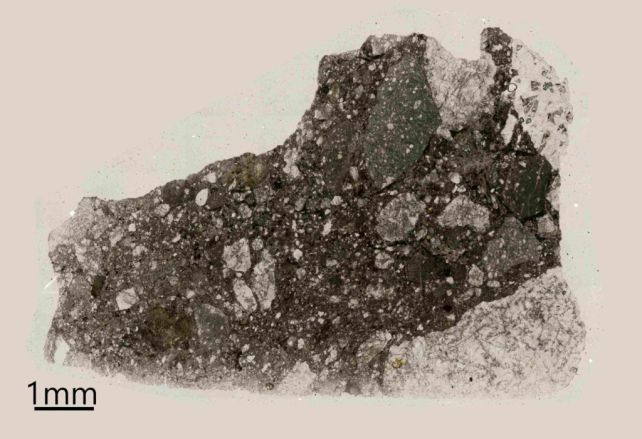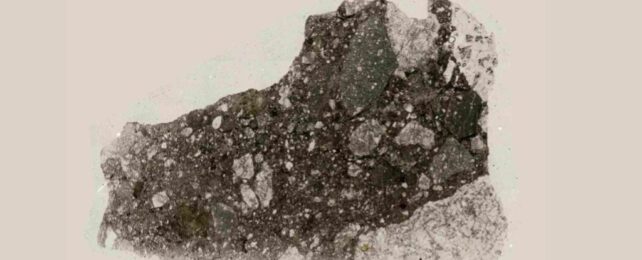When you think of the Moon, the adjective "damp" generally doesn't spring to mind.
Earth's natural satellite is known to be very dry; a gray ball of gunpowder-scented dust and ancient volcanic rock. It's been a long time since anyone thought there might be an ocean of liquid water up there.
Yet the Moon isn't as devoid of water as appearances suggest… and early in its history, it may have been wetter still.
According to a new analysis of a meteorite determined to have originated on the Moon, the lunar crust was once far richer in water than we previously thought. A team led by lunar geoscientist Tara Hayden of the University of Western Ontario found a mineral therein that suggests the lunar crust was rich in volatile elements 4 billion years ago, including water.
That mineral is a common phosphate known as apatite, and it's the first time we've ever seen apatite in material from the Moon.
"The discovery of apatite in the Moon's early crust for the first time is incredibly exciting – as we can finally start to piece together this unknown stage of lunar history," Hayden says.
"We find the Moon's early crust was richer in water than we expected, and its volatile stable isotopes reveal an even more complex history than we knew before."
When scientists got all up in the Moon's business with the Apollo missions, they noticed something strange. The Moon seemed seriously depleted in volatiles such as carbon, chlorine, hydrogen, and sulfur, compared to Earth. The presence of these other volatiles strongly implies the presence of water, so the conclusion was that the Moon must be, and must have always been, "bone-dry".
But there have been ongoing hints that the Moon is not as dry and bare as we thought. Water has been found trapped in lunar volcanic glass. It's also thought to be trapped as ice in deep, shadowed craters.

We've had a difficult time studying the history of the Moon's volatiles due to a lack of volatile-bearing minerals to study – apatite in particular. But when Hayden was asked to verify a rock sample for a collector, she found not only was the rock originally from the Moon, it contained quite a bit of apatite.
The rock itself, named Arabian Peninsula 007, is a piece of lunar breccia consisting of a bunch of different minerals bound together in a rock matrix, a bit like a mineral fruit cake. Apatite was found in most of the different mineral types identified in the specimen, the researchers said.
This suggests that the Apollo samples cannot be taken as relevant to other parts of the Moon – that local lunar rocks tell different parts of the Moon's story.
"We know most about the history of water on the Moon from the Apollo samples, but those samples are thought to only represent about five per cent of the entire Moon surface," Hayden says.
"I was so lucky the meteorite not only came from the Moon but remarkably, featured chemistry so vital to our understanding about lunar water-bearing minerals."
At the moment, our ability to probe the chemistry of the Moon is extremely limited, but a new lunar era is blooming. Multiple space agencies are planning lunar missions, and NASA's Artemis program is aiming to put humans on the Moon in 2026. So although we don't have a lot of answers now, it may not be long until we do.
Until then, lunar meteorites offer a window into the Moon's history – and where its water may be hiding.
"It has been long believed the lunar surface has been dried out for thousands and even millions of years, but maybe there might be more water available than we thought on the surface of the Moon and we just need to find a way to extract it," Hayden says.
The research has been published in Nature Astronomy.
